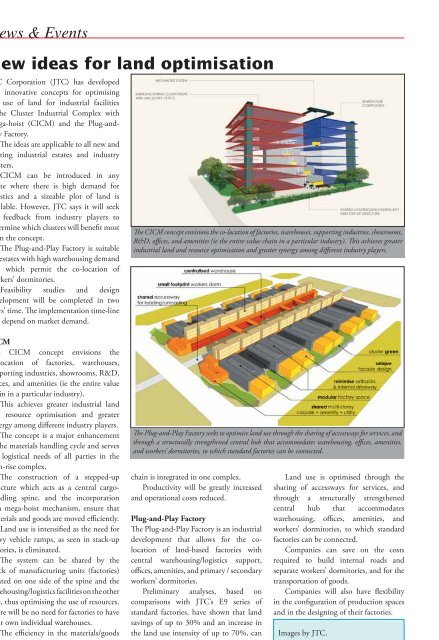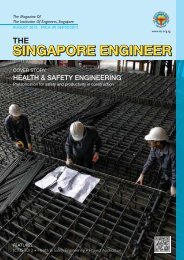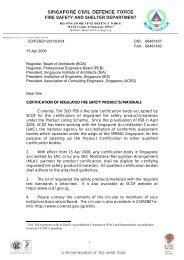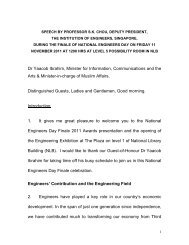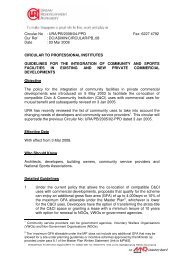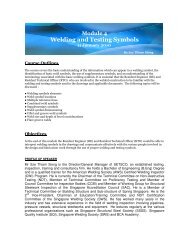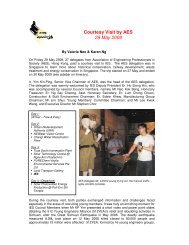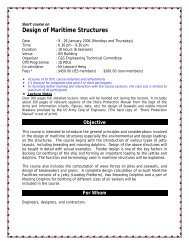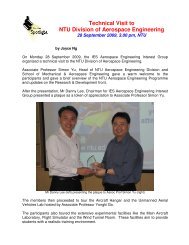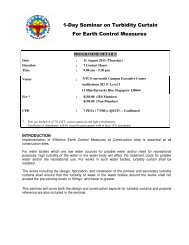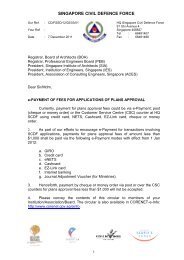News & Events - Institution of Engineers Singapore
News & Events - Institution of Engineers Singapore
News & Events - Institution of Engineers Singapore
Create successful ePaper yourself
Turn your PDF publications into a flip-book with our unique Google optimized e-Paper software.
<strong>News</strong> & <strong>Events</strong><br />
New ideas for land optimisation<br />
JTC Corporation (JTC) has developed<br />
two innovative concepts for optimising<br />
the use <strong>of</strong> land for industrial facilities<br />
– the Cluster Industrial Complex with<br />
Mega-hoist (CICM) and the Plug-and-<br />
Play Factory.<br />
The ideas are applicable to all new and<br />
existing industrial estates and industry<br />
clusters.<br />
CICM can be introduced in any<br />
estate where there is high demand for<br />
logistics and a sizeable plot <strong>of</strong> land is<br />
available. However, JTC says it will seek<br />
the feedback from industry players to<br />
determine which clusters will benefit most<br />
from the concept.<br />
The Plug-and-Play Factory is suitable<br />
for estates with high warehousing demand<br />
and which permit the co-location <strong>of</strong><br />
workers’ dormitories.<br />
Feasibility studies and design<br />
development will be completed in two<br />
years’ time. The implementation time-line<br />
will depend on market demand.<br />
The CICM concept envisions the co-location <strong>of</strong> factories, warehouses, supporting industries, showrooms,<br />
R&D, <strong>of</strong>fi ces, and amenities (ie the entire value chain in a particular industry). This achieves greater<br />
industrial land and resource optimisation and greater synergy among different industry players.<br />
CICM<br />
The CICM concept envisions the<br />
co-location <strong>of</strong> factories, warehouses,<br />
supporting industries, showrooms, R&D,<br />
<strong>of</strong>fices, and amenities (ie the entire value<br />
chain in a particular industry).<br />
This achieves greater industrial land<br />
and resource optimisation and greater<br />
synergy among different industry players.<br />
The concept is a major enhancement<br />
to the materials handling cycle and serves<br />
the logistical needs <strong>of</strong> all parties in the<br />
high-rise complex.<br />
The construction <strong>of</strong> a stepped-up<br />
structure which acts as a central cargohandling<br />
spine, and the incorporation<br />
<strong>of</strong> a mega-hoist mechanism, ensure that<br />
materials and goods are moved efficiently.<br />
Land use is intensified as the need for<br />
heavy vehicle ramps, as seen in stack-up<br />
factories, is eliminated.<br />
The system can be shared by the<br />
block <strong>of</strong> manufacturing units (factories)<br />
located on one side <strong>of</strong> the spine and the<br />
warehousing/logistics facilities on the other<br />
side, thus optimising the use <strong>of</strong> resources.<br />
There will be no need for factories to have<br />
their own individual warehouses.<br />
The efficiency in the materials/goods<br />
movement cycle is improved as the value<br />
The Plug-and-Play Factory seeks to optimise land use through the sharing <strong>of</strong> accessways for services, and<br />
through a structurally strengthened central hub that accommodates warehousing, <strong>of</strong>fi ces, amenities,<br />
and workers’ dormitories, to which standard factories can be connected.<br />
chain is integrated in one complex.<br />
Productivity will be greatly increased<br />
and operational costs reduced.<br />
Plug-and-Play Factory<br />
The Plug-and-Play Factory is an industrial<br />
development that allows for the colocation<br />
<strong>of</strong> land-based factories with<br />
central warehousing/logistics support,<br />
<strong>of</strong>fices, amenities, and primary / secondary<br />
workers’ dormitories.<br />
Preliminary analyses, based on<br />
comparisons with JTC’s E9 series <strong>of</strong><br />
standard factories, have shown that land<br />
savings <strong>of</strong> up to 30% and an increase in<br />
the land use intensity <strong>of</strong> up to 70%, can<br />
be achieved.<br />
Land use is optimised through the<br />
sharing <strong>of</strong> accessways for services, and<br />
through a structurally strengthened<br />
central hub that accommodates<br />
warehousing, <strong>of</strong>fices, amenities, and<br />
workers’ dormitories, to which standard<br />
factories can be connected.<br />
Companies can save on the costs<br />
required to build internal roads and<br />
separate workers’ dormitories, and for the<br />
transportation <strong>of</strong> goods.<br />
Companies will also have flexibility<br />
in the configuration <strong>of</strong> production spaces<br />
and in the designing <strong>of</strong> their factories.<br />
Images by JTC.<br />
40 · THE SINGAPORE ENGINEER Jun 2010


